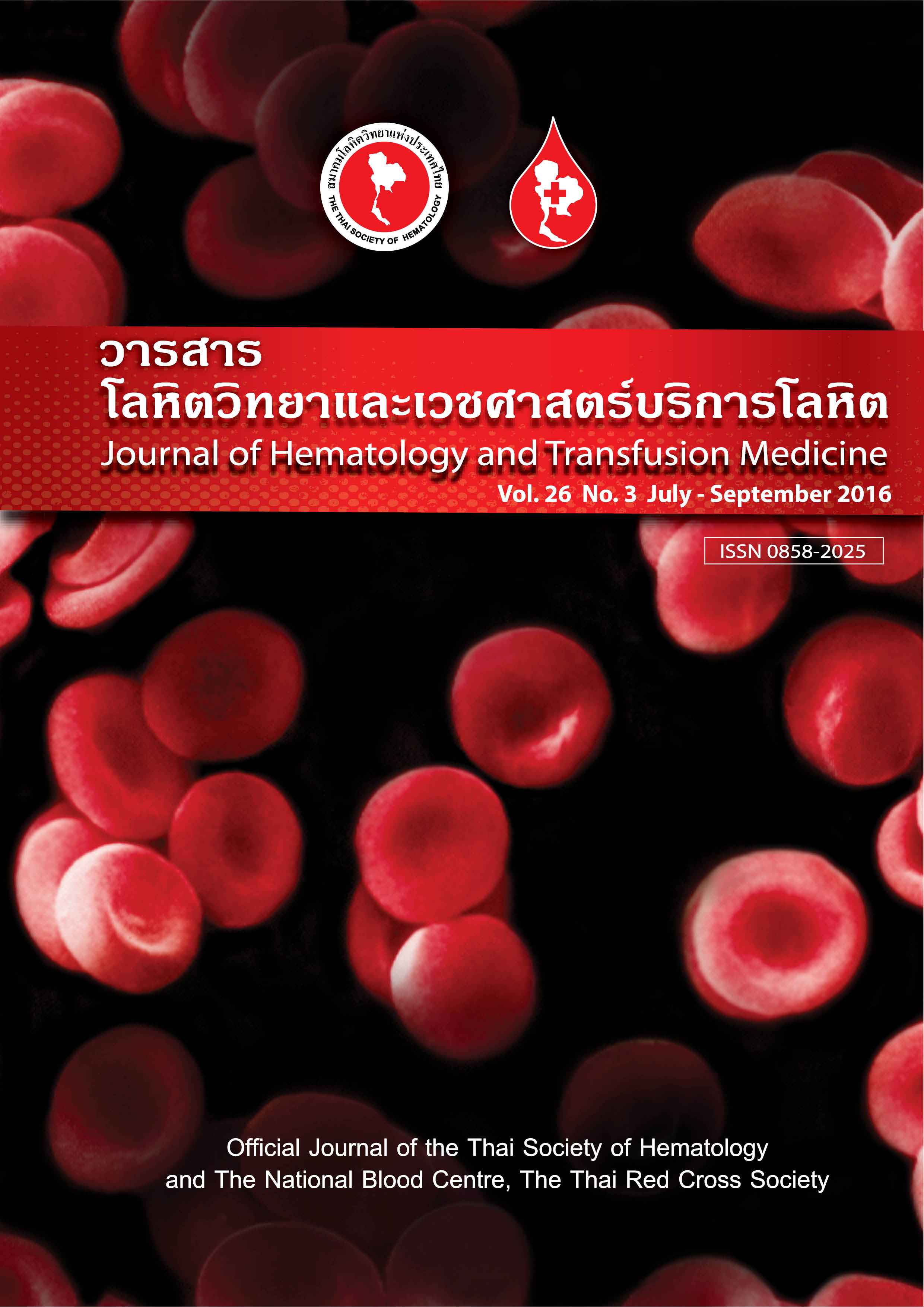ABH Secretor Status in the Thai Population
Keywords:
ABH secretors, ABO blood groups, Saliva hemagglutination inhibition test, Thai populationAbstract
Abstract
ABO blood groups and ABH saliva secretion were investigated in the Thai population. A total of 206 blood donors and 2 families, of 3 and 4 members, respectively, were subjected to the study at National Blood Centre, The Thai Red Cross Society. The study was conducted from July 22nd to August 26th, 2016. ABO blood grouping was examined by both cell and serum grouping. Saliva from blood donors was collected and hemagglutination inhibition test (HAI) was used to detect the secretor status. It was found that the gene frequencies of O, A and B were 0.646, 0.142 and 0.212, respectively. The frequencies of Se and se genes were found to be 0.4603 and 0.5397, respectively. It was concluded that among the Thai population, 70.87% were secretors and 29.13% were non-secretors, which was similar to the studies in other populations. The frequencies of secretor status in different ABO blood groups were 74.42% in O, 64.29% in A, 74.63% in B and 45.45% in AB, and the frequencies of secretor status in men and women were 68.00% and 73.58%, respectively. However, there were no significant differences in the secretor status among genders and in blood groups O, A and B (p > 0.05), though there were significant differences in the secretor status when comparing blood group AB with blood groups O and B (p < 0.05) but no significant differences when comparing with blood group A (p > 0.05). The family studies have clearly shown the genetic heritage of Se and se genes in the first family, while in the second family, everyone was an ABH secretor. In conclusion, the frequency of the ABH secretors in the Thai population was comparable with other populations and the detection of saliva ABH substances was able to confirm the obscure ABO blood group determination among the ABH secretors.
บทคัดย่อ
ได้ทำการศึกษาหมู่โลหิต ABO และการหลั่งสาร ABH ในประชากรไทยจำนวน 206 คน รวมทั้งศึกษา 2 ครอบครัวที่มีสมาชิก 3 และ 4 คนตามลำดับ ณ ศูนย์บริการโลหิตแห่งชาติ สภากาชาดไทย ระหว่างวันที่ 22 กรกฎาคม ถึง 26 สิงหาคม 2559 วิธีการทดสอบหมู่โลหิต ตรวจทั้ง cell และ serum grouping สำหรับการตรวจสาร ABH ในน้ำลาย ใช้วิธี hemagglutination inhibition (HAI) ผลการศึกษาพบว่าความถี่ของยีน O, A และ B เท่ากับ 0.646, 0.142 และ 0.212 ตามลำดับ ความถี่ของยีน Se และ se เท่ากับ 0.4603, 0.5397 ตามลำดับ สามารถสรุปได้ว่าคนไทยเป็น secretor ร้อยละ 70.87 และเป็น non secretor ร้อยละ 29.13 ซึ่งใกล้เคียงกับที่พบรายงานในประชากรอื่นๆ ความถี่ของผู้ที่หลั่งสาร ABH แยกตามหมู่โลหิตเท่ากับร้อยละ 74.42 ในหมู่ O ร้อยละ 64.29 ในหมู่ A ร้อยละ 74.63 ในหมู่ B และร้อยละ 45.45 ในหมู่ AB ความถี่ของผู้หลั่งสาร ABH ในผู้ชายและผู้หญิงเท่ากับร้อยละ 68.00 และร้อยละ 73.58 ตามลำดับ อย่างไรก็ดีความแตกต่างทั้งในระหว่างเพศและหมู่โลหิต O, A และ B ของผู้หลั่งสาร ไม่มีนัยสำคัญทางสถิติ (p > 0.05) และถึงแม้ว่าเมื่อเปรียบเทียบผู้หลั่งสารในหมู่โลหิต AB กับหมู่โลหิต O และ B มีความแตกต่างอย่างมีนัยสำคัญ (p < 0.05) แต่เมื่อเปรียบเทียบผู้หลั่งสารในหมู่โลหิต AB กับหมู่โลหิต A ไม่มีความแตกต่างอย่างมีนัยสำคัญ (p > 0.05) การถ่ายทอดยีน Se และ se สามารถเห็นได้ชัดเจนใน 1 ครอบครัว ส่วนอีกครอบครัวพบว่าเป็น ABH secretor ทุกคน โดยสรุป การศึกษานี้แสดงว่าสภาวะการหลั่งสาร ABH ในน้ำลายในประชากรไทย มีความถี่เช่นเดียวกับประชากรอื่นๆ และสามารถใช้การตรวจสาร ABH ในน้ำลาย เพื่อยืนยันหมู่โลหิต ABO ในกลุ่ม secretors ที่การตรวจปกติให้ผลไม่ชัดเจน



